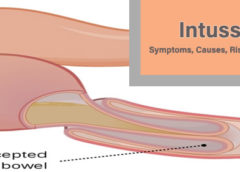What is intussusception?
Intussusception is a condition that causes an intestinal obstruction (blockage) in one segment of the intestine ‘telescopes’ inside another. While intussusception can occur anywhere in the gastrointestinal tract, it typically occurs at small and large intestine junctions. The obstruction can cause swelling and inflammation which can result in bowel injury.
The exact cause of intussusception is unknown. In most cases, it is followed by a virus that causes the lining of the intestine to swell, and then falls into the bowel below. In some babies, it is caused by a disorder that the child is born with, such as a polyp or diverticulum.
What are the primary symptoms of intussusception?
Intussusception doesn’t always arrive with noticeable symptoms. When symptoms do begin, they usually start suddenly. This is true for both children and adults.
Pain is the most common symptom of intussusception but other signs can also occur. Older kids and adults may only have pain and none of the other common symptoms.
Symptoms in children
Because intussusception is the most common in children under 3, their symptoms may not be described. A sudden cry of pain can be the first clue of trouble.
Young kids can bend or try to pull their knees up to their chest. Bouts of abdominal pain may come and go every 15 minutes or so. Every period they last longer, before treatment starts.
Other symptoms in children may include:
- Nausea and vomiting
- Diarrhea
- Stool mixed with blood and mucus
- Fever
- Little or no energy
You may also be able to feel a small lump in the lower abdomen.
Symptoms in Adults
Among the challenges of diagnosing intussusception in adults are that it’s rare and is usually accompanied by nonspecific symptoms.
If signs of adult intussusception are present, they can include abdominal pain as well as nausea and vomiting. These symptoms may come and go, sometimes causing people to go weeks before they seek medical treatment.
When to seek medical attention?
Intussusception is a medical emergency. Call your doctor or get emergency medical help immediately if your child has any intussusception symptoms, such as:
- Repeated crampy belly pain
- Vomiting
- Drowsiness
- Passing of currant jelly stool
Most babies treated within the first 24 hours completely recover without any problems. But untreated intussusception can cause serious problems, which quickly get worse. So it’s important to get help right away — every second count.
Causes
Your intestine is shaped like a long tube. One part of your intestine — normally the small intestine — slips through an adjacent portion in intussusception. This is sometimes called telescoping because the way a collapsible telescope folds together is similar.
The telescoping is caused in some cases by an abnormal growth of the intestine, such as a polyp or tumor (called a lead point). The standard wave-like contractions of the intestine grab this lead point and bring it in front of the intestine and it’s lining into the intestine. In most cases, however, no cause for intussusception can be identified.
Children
The cause is unknown in the vast majority of instances of intussusception in infants. Because intussusception seems to occur more frequently in the fall and winter and because many children with the problem also have flu-like symptoms, some suspect that a virus can play a part in the condition. Sometimes a lead point can be identified as the cause of the condition — most often the lead point is the diverticulum of a Meckel (a pouch in the small intestine’s lining).
Adults
Intussusception in adults is normally the result of a medical condition or procedure including:
- A polyp or tumor
- Scar-like tissue in the intestine (adhesions)
- Operation with weight loss (gastric bypass) or other surgery to the intestinal tract
- inflammation from diseases including Crohn’s disease
Risk factors
Young children are more at risk of intussusception.
75 per cent of cases in children occur in the first 2 years of life, according to the American Pediatric Surgical Association. It also occurs more frequently in males.
One study indicates that risk factors for child intussusception can include:
• Infections
• Cystic Fibrosis
• Intestinal Polyps
The same source suggests the following risk factors for adults:
• Endometriosis
• Bowel Adhesions
• Intestinal Tumors
Family history of an earlier episode of intussusception may also place someone at greater risk.
Complications
Intussusception can cut off the flow of blood to the affected portion of the gut. When left untreated, blood shortages cause bowel tissue to die. Death of the tissue can result in tear (perforation) in the intestinal wall, which can cause an infection of the abdominal cavity lining.
Peritonitis is a life-threatening condition that requires immediate medical attention. Signs and symptoms of peritonitis include:
- Abdominal pain
- Abdominal swelling
- Fever
Peritonitis will make your child feel surprised. Signs and shock effects include:
- Cool, clammy skin that may be pale or grey
- A weak and rapid pulse
- Abnormal breathing that may be either slow and shallow or very rapid
- Anxiety or agitation
- Profound listlessness
- Abnormal breathing which can be either sluggish and shallow or very rapid
A child in shock could be either conscious or unconscious. If you think your child is in shock, seek emergency medical attention right away.

Leave a Reply
You must be logged in to post a comment.